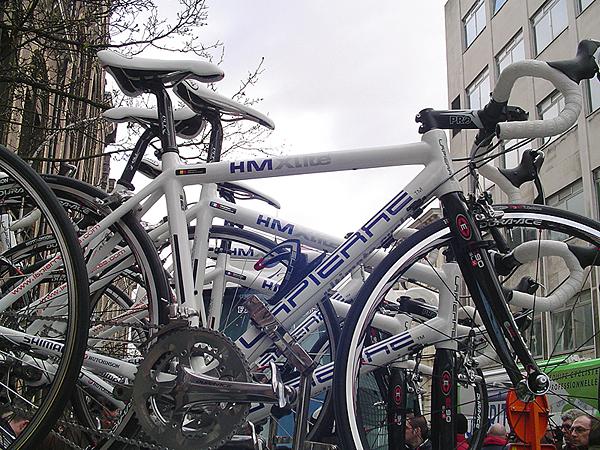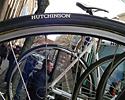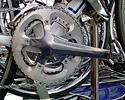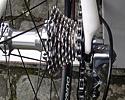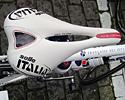
Recently on Cyclingnews.com |
Pro bikes, March 11, 2008
Philippe Gilbert's Française des Jeux Lapierre HM X-Lite
Gilbert's Het Volk winning houndBy Jeff Jones What makes a good classics bike? We took a close look at Het Volk winner Philippe Gilbert's Lapierre HM X-Lite. ProTour team La Française des Jeux has started the season well: Belgian star Philippe Gilbert has already won two races and the overall in the Mallorca Challenge as well as an impressive victory in the Omloop Het Volk earlier this month. The team has been riding French Lapierre bikes since 2002 and Gilbert's HM X-Lite machine proved to be well suited to the cobbles in Het Volk as he blasted away with 50km to go and soloed to victory. The unrelenting pounding that the northern classics deliver might suggest that a softer frame would be in order. However, like many top pros, Gilbert apparently still prioritises frame rigidity over comfort and opts for the HM X-Lite frame over Lapierre's markedly more compliant S-Lite model. According to Lapierre, the HM X-Lite is actually the most rigid frame it makes thanks to its high modulus carbon fibre content and tube-to-tube construction techniques. The geometry is uniform across all Lapierre road frames. Gilbert's 55cm model features an effective 57cm-long top tube (measured centre-to-centre) and a 55cm-long seat tube (measured centre-to-top). This is combined with a seat angle of 72.5 degrees and a head angle of 73 to give what should be a stable ride. That's exactly what you want when you're battling the wind, bouncing over the cobbles and dodging potholes. There are enough surprises in a Flemish semi-classic without worrying about bike handling. Some comfort is provided, however, by the Easton EC90 SLX carbon fork. It's among the lightest fork available at approximately 300g and also notably more compliant than many others out there but proven to be strong enough to withstand Belgian pavé. Gilbert's bike is fitted with a full Shimano Dura-Ace groupset, right down to the wheels, pedals and relatively standard 53/39T and 11-23T gearing. While the frame and fork are made almost exclusively of carbon fiber, there's virtually none of it to be found elsewhere on Gilbert's Het Volk machine. In fact, most teams stick with alloy in the northern classics as having slightly heavier components is a small price to pay for a little more insurance on the cobbles. One such example is Gilbert's Shimano WH-7850-SL clincher wheelset whose toughness and predictable handling outweighs the slight weight and aerodynamic disadvantage of its 23mm-deep scandium alloy rims. The entire team also opts for Hutchinson's Fusion 2 tubeless (700x23c) on all their bikes. These are still catching on in the road cycling world, as they're not the easiest things to install, but they roll well and offer great grip. Those watching Gilbert fly around muddied cobbled corners during his ride would have been impressed at how sticky these tyres were. We should perhaps say tyre, though, as Gilbert finished on a different rear wheel than he started on likely because of an early puncture. This looked to be similar to the wheels on his spare bike, which were box section rims shod with Hutchinson Carbon Comp tubulars. The Shimano theme extends to the bars, stem and seatpost, all of which bear the PRO PLT name. Carbon has again been avoided in favour of aluminium for the bars and stem but Gilbert's bike is fitted with a composite post. The saddle is a Selle Italia SLR Gel Flow to assist in the comfort stakes where it counts. Finally, the bottle cages are Elite's low-end but very cobble-friendly Cuissi Gel cages. Looking at the Lapierre HM X-Lite as a whole, it's easy to see why this bike performed so well in a cobbled semi-classic like Het Volk. It's interesting that carbon has been avoided everywhere except the frame, but it's obvious that the extra weight involved didn't slow Gilbert down nor his teammate, Arnaud Gerard, who was in the early break and played an important role towards the finish by protecting his captain from the wind. With just over a month's time before Paris-Roubaix, it's unlikely that Francaise des Jeux will make many equipment changes before tackling the hardest cobbled classic of them all and we'd be surprised to see Gilbert aboard a substantially different machine come April. PhotographyFor a thumbnail gallery of these images, click here Images by Roberto Bettini/www.bettiniphoto.net
Images by Jeff Jones/BikeRadar.com
| |||||
Full specificationFrame: Lapierre HM X-Lite Front brake: Shimano Dura-Ace BR-7800 |
Wheelset: Shimano Dura-Ace WH-7850-SL Bars: PRO PLT Round OS Pedals: Shimano Dura-Ace PD-7850 | ||||

